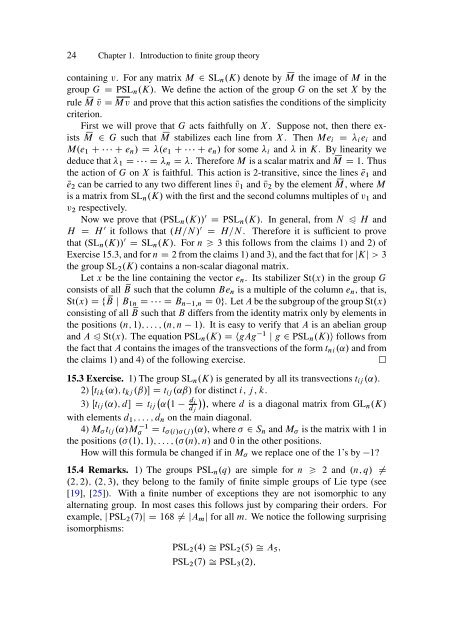Create successful ePaper yourself
Turn your PDF publications into a flip-book with our unique Google optimized e-Paper software.
24 Chapter 1. <strong>Introduction</strong> <strong>to</strong> <strong>finite</strong> <strong>group</strong> <strong>theory</strong><br />
containing v. For any matrix M 2 SL n .K/ denote by SM the image of M in the<br />
<strong>group</strong> G D PSL n .K/. We define the action of the <strong>group</strong> G on the set X by the<br />
rule SM Nv D Mv and prove that this action satisfies the conditions of the simplicity<br />
criterion.<br />
First we will prove that G acts faithfully on X. Suppose not, then there exists<br />
SM 2 G such that SM stabilizes each line from X. Then Me i D i e i and<br />
M.e 1 CCe n / D .e 1 CCe n / for some i and in K. By linearity we<br />
deduce that 1 DD n D . Therefore M is a scalar matrix and SM D 1. Thus<br />
the action of G on X is faithful. This action is 2-transitive, since the lines Ne 1 and<br />
Ne 2 can be carried <strong>to</strong> any two different lines Nv 1 and Nv 2 by the element SM , where M<br />
is a matrix from SL n .K/ with the first and the second columns multiples of v 1 and<br />
v 2 respectively.<br />
Now we prove that .PSL n .K// 0 D PSL n .K/. In general, from N H and<br />
H D H 0 it follows that .H=N / 0 D H=N. Therefore it is sufficient <strong>to</strong> prove<br />
that .SL n .K// 0 D SL n .K/. For n > 3 this follows from the claims 1) and 2) of<br />
Exercise 15.3, and for n D 2 from the claims 1) and 3), and the fact that for jKj >3<br />
the <strong>group</strong> SL 2 .K/ contains a non-scalar diagonal matrix.<br />
Let x be the line containing the vec<strong>to</strong>r e n . Its stabilizer St.x/ in the <strong>group</strong> G<br />
consists of all xB such that the column Be n is a multiple of the column e n , that is,<br />
St.x/ DfxB j B 1n DDB n 1;n D 0g. Let A be the sub<strong>group</strong> of the <strong>group</strong> St.x/<br />
consisting of all xB such that B differs from the identity matrix only by elements in<br />
the positions .n;1/;:::;.n;n 1/. It is easy <strong>to</strong> verify that A is an abelian <strong>group</strong><br />
and A St.x/. The equation PSL n .K/ DhgAg 1 j g 2 PSL n .K/i follows from<br />
the fact that A contains the images of the transvections of the form t ni .˛/ and from<br />
the claims 1) and 4) of the following exercise.<br />
<br />
15.3 Exercise. 1) The <strong>group</strong> SL n .K/ is generated by all its transvections t ij .˛/.<br />
2) Œt ik .˛/; t kj .ˇ/ D t ij .˛ˇ/ for distinct i, j , k.<br />
d<br />
3) Œt ij .˛/; d D t ij ˛ 1 i<br />
<br />
d j<br />
, where d is a diagonal matrix from GLn .K/<br />
with elements d 1 ;:::;d n on the main diagonal.<br />
4) M t ij .˛/M<br />
1 D t .i/.j/ .˛/, where 2 S n and M is the matrix with 1 in<br />
the positions ..1/; 1/;:::;..n/; n/ and 0 in the other positions.<br />
How will this formula be changed if in M we replace one of the 1’s by 1<br />
15.4 Remarks. 1) The <strong>group</strong>s PSL n .q/ are simple for n > 2 and .n; q/ ¤<br />
.2; 2/; .2; 3/, they belong <strong>to</strong> the family of <strong>finite</strong> simple <strong>group</strong>s of Lie type (see<br />
[19], [25]). With a <strong>finite</strong> number of exceptions they are not isomorphic <strong>to</strong> any<br />
alternating <strong>group</strong>. In most cases this follows just by comparing their orders. For<br />
example, j PSL 2 .7/j D168 ¤jA m j for all m. We notice the following surprising<br />
isomorphisms:<br />
PSL 2 .4/ Š PSL 2 .5/ Š A 5 ;<br />
PSL 2 .7/ Š PSL 3 .2/;













